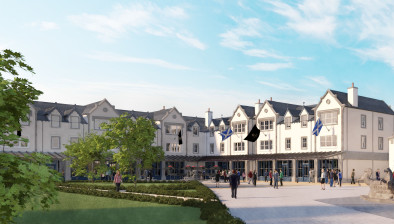Donald Trump’s legal challenge against windfarm near golf course refused

Donald Trump’s appeal against a judge’s dismissal of his legal challenge to a decision to approve the development of a windfarm near his golf course in Aberdeen Bay has been refused.
Trump International Golf Club and the Trump Organization sought judicial review of the decision by the Scottish Ministers to consent to the application and not to hold a public inquiry, but judges in the Inner House of the Court of Session upheld the decision and refused the appeal.
In August 2011, Aberdeen Offshore Wind Farm Limited (AOWFL) applied for consent for the construction and operation of the European Offshore Wind Deployment Centre (EOWDC), a proposed 11-turbine electricity generating centre off the coast of Blackdog, Aberdeenshire – about 3.5 km from Trump’s Menie Links golf resort at Balmedie.
In March 2013 the Scottish Ministers issued a letter to AOWFL intimating their decision not to hold an inquiry and to consent to the application, subject to certain conditions, a decision Mr Trump claimed was “unlawful”, “incompetent” and “in breach of natural justice” as it was “pre-determined” and “bias” in favour of AOWFL.
A petition for judicial review of the decision was refused by Lord Doherty, who said he was not persuaded on the issues of pre-determination and bias.
The Trump Organization then moved to the appeal court seeking to quash the decision or to consider afresh whether to convene a public inquiry.
However, the Lord President, Lord Gill held that the argument was “fallacious”.
In a written opinion, Lord Gill said: “In my opinion, the true interpretation is that the entitlement to apply for a section 36 consent is not limited to the restricted class of persons who are either licensed or exempt; but that where an applicant under section 36 obtains consent, as in this case, for the construction and operation of a generating station, it will require to obtain a licence or an exemption before it can generate electricity in the station. When that party, or its assignee, obtains a licence or an exemption, it then becomes subject to the provisions of Schedule 9, which governs practical considerations such as the impact of the proposal on the environment in the broadest sense.
“I do not accept the submission for the petitioners that, on the view that I have taken, a non-licence holder or a non-exempt person escapes a duty to mitigate the impact of its proposal under paragraph 3(1)(b) of Schedule 9. There is no escape from that duty. Every successful applicant for consent under section 36 will sooner or later become subject to Schedule 9 for the simple reason that no party that is granted such a consent can thereafter generate electricity without either a licence or an exemption.”
Counsel for the petitioners also argued that if one looked at the process overall, it was clear that from its inception the project had “considerable official support”.
AOWFL and associated bodies received “substantial financial assistance” from public sources and it was “sympathetically and supportively considered by the officials of the Scottish Ministers throughout the section 36 process, but the Lord President rejected the submissions that the decision-making process was “unfair”.
“The case for the petitioners fails, in my view, to distinguish between a predisposition to favour a proposal and a predetermination to decide in favour of it, come what may,” he said.
The petitioners further argued that in the absence of an enforcement mechanism to ensure that the design principles are complied with, the consent was “invalid”.
It was said that the design was an important part of the development, particularly in relation to its impact on users of the petitioners’ golf course, but that the design of the development was “uncontrolled”.
However, Lord Gill noted that condition 14 stated that the construction method statement and the detailed design statement were subject to the written approval of Scottish Ministers after due consultation with Scottish National Heritage.
He explained: “The approval of these two documents is a condition precedent to the construction. If a design statement is not satisfactory to the Ministers, there will be no approval of the construction method statement without which the development cannot begin. There is no ambiguity when condition 14 is read in that way.”















